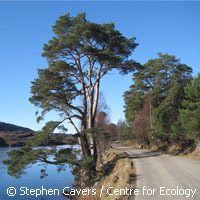EU research offers hope for future of iconic Scots Pine
Fears that the Scots Pine tree could die out in Scotland because of a lack of genetic variation are most likely unfounded, according to European researchers. They have discovered that the iconic forests still carry traces of their ancestors and still harbour genetic variation that could help regenerate future populations. The work, presented in the journal Heredity, is an outcome of the EVOLTREE ('Evolution of Trees as drivers of terrestrial biodiversity') project, which received EUR 14.3 million under the 'Sustainable development, global change and ecosystems' Thematic area of the EU's Sixth Framework Programme (FP6). The Scots Pine forests found in Highland Scotland today are all that is left of the ancient, much larger Caledonian forest that covered much of northern Britain from the end of the last Ice Age until many trees were lost due to over-exploitation and intensive agriculture more than 400 years ago. Scientists previously thought that because the trees were lost so was much of the genetic diversity contained within them. They were concerned that a lack of genetic diversity would make it difficult for the remaining pine tree populations to adapt and survive under new conditions, for example as the climate changes. So researchers from the Centre for Ecology & Hydrology (CEH) in the UK, the Polish Academy of Sciences, the University of Edinburgh and the Macaulay Land Use Research Institute in Scotland studied the remnant Scottish populations to see exactly how much genetic variation remains. They also examined how these trees compare to the intact Scots Pine forests of continental Europe and Asia. By studying similarities in the genes of Scots Pine trees, the scientists discovered that the Scottish pine forests still carry traces of their ancestors that colonised Britain after the end of the last Ice Age and therefore harbour enough genetic variation to potentially help regenerate future populations. They also found that the Scottish populations are at least as genetically diverse as their continental cousins. 'Despite its Scottish image, the Scots Pine owes much to its European roots,' said Dr Stephen Cavers, an ecologist based at CEH's Edinburgh site and co-author of the paper, describing the results of this research. 'By looking at the trees' DNA [deoxyribonucleic acid] we have learnt much about how the forests grew up after the Ice Age. Given the severe fragmentation of the current population, our results are key to understanding how these forests will cope with future change.' However, the scientists admitted that it is difficult to pinpoint where the genetic diversity comes from. They said that since these trees can reach a great age, with some becoming an incredible 700 years old, the forests present today may be no more than a few tens of generations removed from the first migrants to reach the UK after the ice retreated. DNA evidence suggests that these early arrivals came in two waves: one, which reached the far north-western Highlands of Scotland very soon after the ice retreated, possibly via Ireland, and another, which settled in the eastern Highlands, from central Europe. Dr Cavers said his team planned 'to continue the study, to try and discover if there are particular genes which let the Highland trees tolerate the harsh Scottish climate'. If the scientists manage to identify such genes it could help with replanting initiatives as it would allow foresters to only plant new trees that would adapt best to the local climate. This could play a key role in the long-term project that is already underway to protect and restore these ancient remnants of a once huge forest.
Countries
United Kingdom



